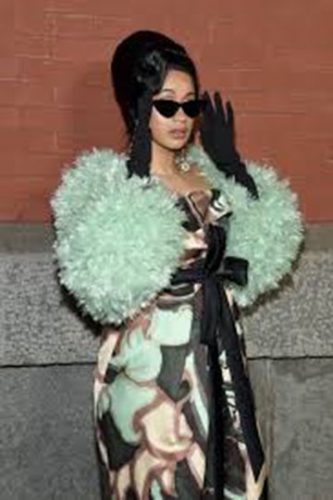
It has now resulted in front rows being only star-studded affairs featuring the likes of Rihanna and Jennifer Lopez and ultimately giving accredited fashion journalists their exit. This year, the star on every designer’s lips is Cardi B, real name Belcalis Almanzar. The 25-year-old, who rose to fame after her hit single “Bodak Yellow” gained popularity by documenting her daily life and thoughts.
Cardi B’s rise wasn’t normal, and this is why I believe that at first many designers opted not to loan her clothing. Cardi was once a stripper and given the pretentiousness of fashion, the industry wanting to sell aspirations through its clothes and the methods brands choose to advertise, I suppose they didn’t see Cardi as a reliable means of doing so. However, Cardi’s addictive sassiness has amassed her approximately 18.5 million followers; brands had to put their pretentious away and give the people what they want.
This brings me to my next point. Do brands really understand the drawbacks they invite when their vision is skewed towards one ideal or one type of consumer? The artistic element to which most creative designers attach themselves, sometimes forces the brand into isolation in what is an ever-changing world.

Years ago in Guyana, there was always a big mystery behind local designer Donna Ramsammy-James’s collections. Her shows were always private affairs that only a select few were chosen to attend. I used to be one of her models and I remember that one of the conditions was that I was not allowed to model for any other designer. In a society where the title designer was being abused, I understood that she was trying to maintain a certain brand elitism. It created a mystery that made you want to be a part of it; kind of like the Guyanese version of being placed on Hermes Birkin Bag waiting list. The two cannot remotely be compared, but they tug at the same insecurity and exclusive feelings fashion thrives on.
Fast forward to 2018, generally what may have worked for brands in the past, don’t work today because the control of style in no longer in the hands of brands but in the consumer. Thanks to the internet, consumers have choices beyond imagination, not to mention varying price points. There is even the option to DIY our sense of style.
Now it is the brands that are seeking accessibility. No brand can risk not altering its product ranges or marketing strategies to be part of the new fashion revolution. Cardi B’s rise to fame and her acceptance to the industry is a gentle reminder that fashion is truly for everyone and anyone.
www.online-runway.com
http://instagram.com/theonlinerunway





